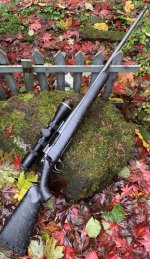A 6.5 Creedmoor in the same weight rifle will have more recoil than a 6mm-06.
I don't understand the man bun or effeminate reference to this rifle cartridge. If Remington had done a better job of marketing the .260 Remington it probably wouldn't exist.
Going back to the 6.5 Swede and other 6.5 military rounds of times past it has proven that it is a sweet spot in that you can shoot a high BC bullet with great sectional density that just works well on both targets as well as game. You don't have to go magnum to get good performance with a 6.5mm / .260 caliber rifle round.
Think of the 6.5 Creedmoor as a short action 6.5 Swedish, because that's basically what it matches performance wise as well as recoil.
There's one thing Remington does better than almost any other company - screw up a cartridge introduction.
The .244 Remington.
Introduced in 1955 the .244 Remington was a better cartridge by any measure than the .243 Winchester. However, Remington screwed up by introducing it in their 722 with a 1-12 twist barrel, which was the slowest twist possible that would stabilize a 90 grain bullet for medium sized game. They did that as they saw the primary market as a varmint rifle shooting lighter bullets.
Customers didn't agree and bought rifles in .243 Win with a 1-9 twist barrel instead as it would stabilize a 100 gr Spire point - and still shot 70-75 grain bullets just fine. The faster twist Winchester chose made the .243 Win a much better dual purpose cartridge than the .244 Rem, even though the .244 Rem was a better cartridge at least 100 fps faster in any bullet weight.
Changing the name to 6mm Remington, along with adopting a faster twist barrel, didn't help as the .243 Win was already firmly established.
The .280 Remington:
It was by nearly all measures a better round than the .270, but Remington made a few key mistakes.
1) In 1957 Remington introduced it in their semi-auto 740 and their slide action 760 and loaded it down to 60,000 psi to accomodate those weaker actions. Loading it down also made no sense has it has the same parent case and head dimensions as the .270 Win, also chambered in those rifles, that operated at 65,000 psi. If they'd have introduced it in their 721 bolt action as a full power round instead, it would have gained a lot of ground over the .270 Win.
2) Remington never capitalized on the popular support it had from notable figures like Jim Carmichael and Steve Hornady.
3) The .280 Rem starts coming into its own at 150 grains and it accells over the .270 Win at bullet weights in the 150 to 175 gr weight range, where it offers near .30-06 performance with less recoil. Remington never quite got that or reflected that in their factory loads.
4) Remington then killed it off on the high end with the 7mm Rem Mag and on the low end with the 7mm-08.
5) Changing the name to 7mm-06 and then just couple months later to the 7mm Express Remington didn't help - it just confused people.
The 7mm-08 Remington
Remington legitimized this wildcat in 1980, and offered in their 700,788 and 7600 rifles. So far so good. However they marketed it as a light recoiling cartridge primarily for youth and women. They NEVER touted it's finer points of excellent 7mm BCs in a short action cartridge with long range potential. You know...like a 7mm version of the 6.5mm Creedmoor, long before the 6.5 CM was even thought of. They also focused on selling it in lightweight rifles, rather than varmint and target rifles, even though it had a great deal of potential in those long range shooting activities.
They also never capitalized on it's .270 Win ballistics in a short action format - again pigeon holing as a light recoiling cartridge for kids and women.
Don't get me wrong, the 7mm-08 is still a popular round as it is an excellent round, but it would have been much more popular had Remington marketed it properly.
The 260 Remington.
The .260 Rem is living proof that Remington learned nothing from it's 7mm-08 experience. Remington simply lacked vision and could not see its way over the top of the box it was in. The .260 Rem and remains superior to the 6.5mm Creedmoor.
However, Remington again marketed it as a lightweight hunting round in lightweight hunting rifles and lighter factory bullet weights. The irony is that Remington was selling the .260 Rem in 1997, a full 10 years before the 6.5 Creedmoor came along and filled the niche that Remington never exploited.

